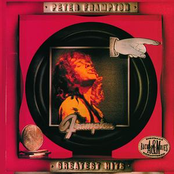Greatest Hits

Biography
Peter Frampton (born 22 April 1950 in Beckenham, Kent) is a British musician, best known today for his multi-platinum selling solo work in the mid-70s when he was an "arena rocker". He originally became famous, however, as a young member of psychedelic era band The Herd and became a teen idol in Britain. Steve Marriott reportedly wanted to bring the 18-year-old Frampton into the Small Faces lineup but ended up starting Humble Pie with Frampton instead. After touring the US and Europe for two y...
Peter Frampton (born 22 April 1950 in Beckenham, Kent) is a British musician, best known today for his multi-platinum selling solo work in the mid-70s when he was an "arena rocker". He originally became famous, however, as a young member of psychedelic era band The Herd and became a teen idol in Britain. Steve Marriott reportedly wanted to bring the 18-year-old Frampton into the Small Faces lineup but ended up starting Humble Pie with Frampton instead.
After touring the US and Europe for two years, he left Humble Pie as the group was gaining popularity because of disdain for Marriott's hard living lifestyle and screaming boogie rock direction. Aside from his work with Humble Pie, other recordings of this era that feature Frampton include albums by Harry Nilsson, Jerry Lee Lewis, and George Harrison. His solo debut was 1972's Wind of Change, which did not fare well on the charts though receiving critical praise. It also featured appearances by musicians such as Ringo Starr and Mick Jones.
Two more efforts by Frampton also struggled commercially, one released under the moniker Frampton's Camel. Constant touring began to create awareness of his talents, however, and 1974's Frampton LP went gold. It also peaked #32 on the Billboard 200 chart in the U.S., showing his growing international appeal.
He finally gained lasting international fame by 1976 when his much-loved live album, Frampton Comes Alive! was released. Having built up his reputation on the road, the LP debuted at No. 1 on the charts in January 1976. It was long considered the best-selling live album of all time, moving over 16 million copies worldwide.
In 1978, Peter suffered a near fatal car crash in the Bahamas, which left him with a concussion, muscle damage and broken bones. But in 1979, he released the album 'Where I Should Be', which went gold and produced the hit 'I Can't Stand It No More'.
His extensive use of the Talk Box effect was and still is an integral part of the Peter Frampton experience.
His albums never regained the high chart placements of the 70's era but he has continued his musical career none the less. Among the gimmicks he's employed to maintain interest have been releasing Frampton Comes Alive II, as well as joining Ringo Starr's touring revue, recording two CDs with ex-Stone Bill Wyman and unsucessfully attempting to reunite with Steve Marriott before his death in 1991. Other notable occasions include starring with the Bee Gees in a film version of The Beatles Sgt Pepper's Lonely Hearts Club Band album and playing with David Bowie on his Never Let Me Down album and tour.
In 2006, Frampton released Fingerprints, a completely instrumental guitar showcase album.
In 2013, two of the ballet’s spring production segments were choreographed to Frampton and his band. A third section featured these new compositions. As Frampton says about the experience: “Writing for dance was a wonderfully freeing experience, There were no boundaries…Songwriters and musicians create music to move people. This was beautiful, graceful, and instantly gratifying!”
“The Promenade’s Retreat” features Frampton laying down some light picking. The verses are few, so we don’t get all that much singing, though Frampton’s voice is very distinctive. There is an easy backbeat provided by drummer Chad Cromwell and Frampton manages his trills, pulls-offs and clean intricate leading.
The title track is a poppy acoustic guitar number. Frampton sings at the high end of his range, we get very Beatlesque sing-able choruses, a tickle of Dobro guitar slide in the bridge, and harmony vocals from Gordon Kennedy. Erik Darken’s congas keep everything slipping along as Frampton leads on top of the concoction, showing his mastery on acoustic as much as he ever has on electric.
“The One in 901” is the first real rock mover and probably the heaviest. There is a chunky Chad Cromwell drumming and Frampton double octave riffing. Over the top, he delivers slightly distorted simple yet effective leads. We even hear some softly sung “ooh’s” before the break out at the end.
“Heart To My Chest” is a delicate tune. Frampton offers up his acoustic yet again for the main voicing and some poignant lyric, his voice breaking even slightly on top of it all. When Blair Master’s piano, Gordon Kennedy’s bass and Cromwell’s drums come in for the choruses, we are in latter-day John Lennon-sounding territory. This tune features guitar and piano descending lines at its end with Frampton offering up clean leads over it. This is the best tune here.
A shuffling mid-tempo beat pushes “Norman Wisdom.” Frampton leads all over the tune on acoustic, offering a fun lyric and Steely Dan-like backing vocals from Kennedy and Frampton. Hummingbird In A Box: Songs For A Ballet is clean, simple, not overly stylized playing from Peter Frampton. The songs are strong enough to stand on their own, ballet or not. We get another example of what Peter Frampton is capable of after five decades.
Peter now resides in Cincinnati, Ohio and can still be found playing concerts around the world.
Read more on Last.fm. User-contributed text is available under the Creative Commons By-SA License; additional terms may apply.



